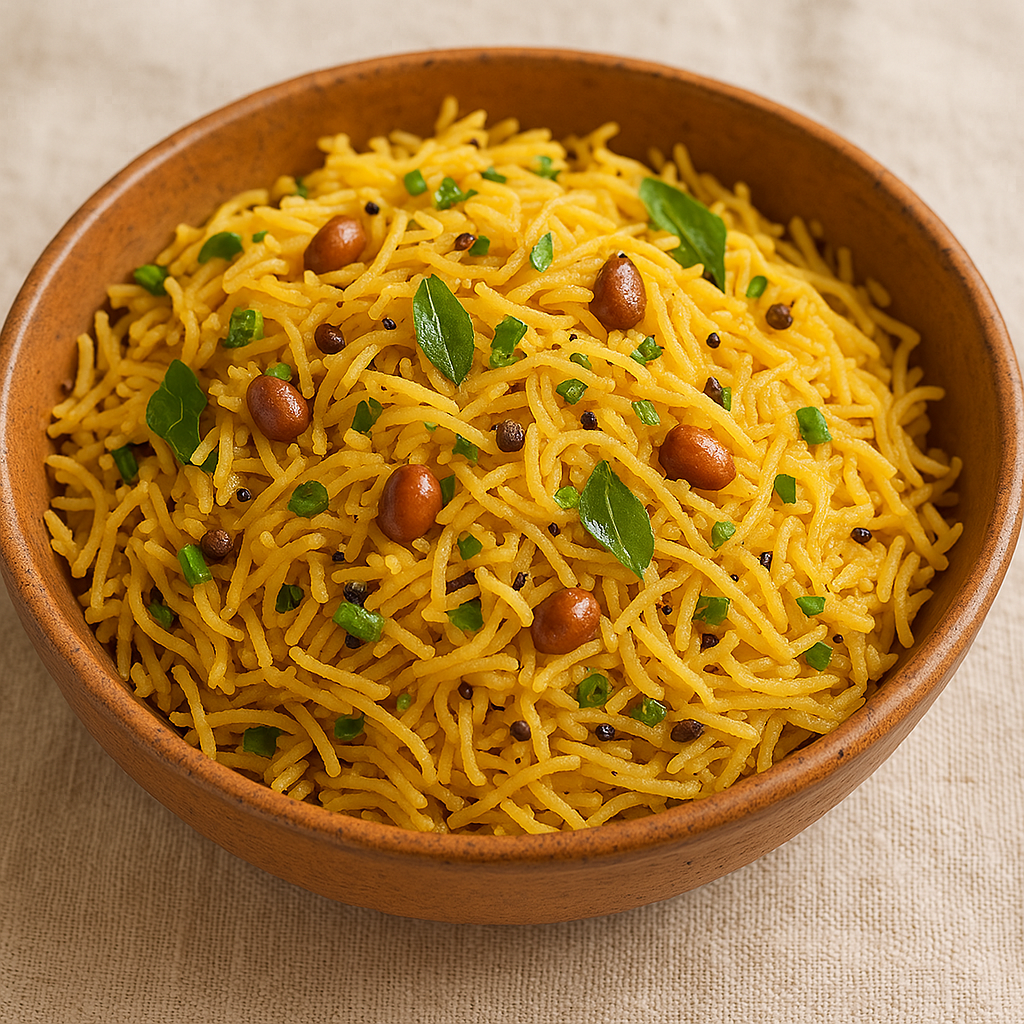Table of Contents
ToggleNamkeen Sevai
Namkeen Sevai – A Delicious Indian Savory Vermicelli Dish
Namkeen Sevai, also known as Savory Vermicelli or Masala Sevai, is a beloved Indian breakfast or evening snack that brings together simplicity, flavor, and nostalgia. It’s made using vermicelli (sevai) — a type of thin pasta similar to spaghetti but much finer — tossed with Indian spices, vegetables, and sometimes nuts to create a light yet satisfying dish.
Namkeen Sevai is widely enjoyed across India, especially in states like Tamil Nadu, Karnataka, Maharashtra, and Andhra Pradesh. While there are sweet versions of sevai (like with jaggery or sugar), the namkeen (salty/spicy) variation stands out for its robust flavors and versatile preparation style.
Origin and Cultural Significance
Namkeen Sevai has roots in South Indian cuisine but has become a staple in many Indian households, transcending regional boundaries. In Tamil Nadu, it’s often referred to as “Upma Sevai”, while in Maharashtra and North India, people simply call it Masala Vermicelli.
It’s one of those dishes that is often associated with home-cooked comfort food. It’s light on the stomach, quick to prepare, and adaptable to whatever ingredients are available in your kitchen, which makes it perfect for busy mornings, unexpected guests, or when you’re in need of a fuss-free meal.
Ingredients Used
The beauty of Namkeen Sevai lies in its simplicity. Here’s a list of common ingredients used:
Main Ingredient:
Vermicelli (Sevai): Available in roasted and unroasted varieties. Roasted sevai saves time and gives a nutty flavor, but if you have unroasted vermicelli, just roast it with a teaspoon of oil until golden brown.
Tempering (Tadka):
Oil or Ghee
Mustard Seeds
Cumin Seeds
Urad Dal (Optional)
Chana Dal (Optional)
Curry Leaves
Dry Red Chilies or Green Chilies
Hing (Asafoetida)
Vegetables:
Onions (finely chopped)
Carrots
Beans
Capsicum
Peas
Tomatoes (optional)
These vegetables are sautéed until slightly tender but still retaining a crunch, giving the dish both flavor and texture.
Flavoring:
Turmeric Powder
Salt
Black Pepper (optional)
Lemon Juice
Coriander Leaves for Garnish
Extras (Optional but Popular):
Roasted Peanuts or Cashews – for crunch
Grated Coconut – for South Indian style
Boiled Potatoes or Paneer Cubes – for added richness
How It’s Made – Cooking Method
Boiling the Vermicelli:
Boil the vermicelli in water until just cooked (al dente).
Drain and rinse with cold water to stop the cooking process.
Toss with a little oil to prevent sticking and set aside.
Tempering:
In a pan, heat oil or ghee.
Add mustard seeds and let them splutter.
Add cumin seeds, urad dal, and chana dal if using.
Toss in curry leaves, green chilies, and a pinch of hing for aroma.
Sautéing Vegetables:
Add chopped onions and sauté till translucent.
Add chopped vegetables of choice and cook until slightly tender.
Mixing It All Together:
Add turmeric powder and salt.
Add the boiled sevai and gently mix with the masala and vegetables.
Cook for a couple of minutes to let the flavors infuse.
Finish with lemon juice and garnish with coriander.
Serve Hot:
Namkeen Sevai is best enjoyed hot, often accompanied by a cup of tea or coconut chutney.
Why People Love Namkeen Sevai
Quick and Easy: Takes about 15-20 minutes to make.
Customizable: You can tweak the ingredients based on what’s available.
Nutritious: When packed with vegetables and cooked with minimal oil, it becomes a healthy meal option.
Perfect for All Ages: From kids to elderly family members, it suits everyone’s palate.
Meal for Any Time: Works great as breakfast, snack, light lunch, or even dinner.
Variations of Namkeen Sevai
South Indian Style: With mustard seeds, curry leaves, coconut, and a simple tempering.
Maharashtrian Style: Spicier version with goda masala or red chili powder.
Upma Sevai: Very similar to rava upma but with sevai instead of semolina.
Tomato Sevai: A tangy twist using tomato purée or chopped tomatoes.
Lemon Sevai: Light and zesty version with minimal spices and lots of lemon juice.
Serving Suggestions
Namkeen Sevai is usually served on its own, but it also pairs well with:
Coconut Chutney
Mint Chutney
Plain Yogurt or Raita
Pickles
Masala Tea or Filter Coffee
For a fuller meal, you can serve it with a side of boiled eggs, papad, or fried potatoes.
Storage and Meal Prep Tips
Refrigeration: Leftover Namkeen Sevai can be stored in an airtight container in the fridge for up to 2 days.
Reheating: Sprinkle a few drops of water and reheat in a pan or microwave. It retains its taste quite well.
Meal Prep: Chop veggies and roast vermicelli in advance to make cooking faster.
Health Benefits
Namkeen Sevai can be a healthy meal if made with:
Whole wheat or millet-based vermicelli
Low oil
Loads of vegetables
No processed ingredients
It’s low in calories and easy on digestion, making it suitable for all age groups and even for people on a light diet.
Conclusion
Namkeen Sevai is more than just a simple dish — it’s a reminder of home, warmth, and the magic of Indian home cooking. Its savory flavors, ease of preparation, and endless variations make it a must-have recipe in every Indian kitchen. Whether you’re a beginner in the kitchen or a seasoned cook, Namkeen Sevai never fails to deliver satisfaction in every bite.
Next time you’re craving something savory, quick, and wholesome — whip up a bowl of Namkeen Sevai. You’ll be surprised how such humble ingredients can come together to create something so comforting and flavorful.

